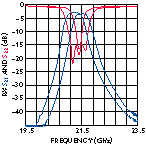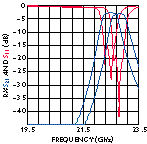ELECTRONICALLY TUNABLE RF DIPLEXERS FOR MICROWAVE RADIO APPLICATIONS

Commercially available RF diplexers consist of two fixed bandpass filters sharing a common port. Signals applied to the common port are separated in accordance with the passband frequency of each filter network. Signals applied to either noncommon port, A or B, are isolated from the other noncommon port and are combined at the common port as shown in Figure 1.
Fixed diplexers are commonly used in point-to-point and point-to-multipoint radios where two-way communication enables voice, video and data traffic within the 20 to 40 GHz frequency range. These radios are frequently used in the last mile of the communication link, connecting consumers to services such as high speed Internet access.
A new line of electronically tunable RF (ETRF) diplexers has been recently developed for microwave radio applications. ETRF diplexers offer service providers flexibility and scalability never before accessible. A single diplexer solution enables radio manufacturers to replace several fixed diplexers covering adjacent frequencies. This versatility provides front end RF tunability in real time applications and decreases deployment and maintenance costs through software controls and reduced component count. Additionally, custom narrowband ETRF diplexer solutions are also available for tunable channel selectivity.

Fig. 1 Diplexer block diagram.
An ETRF diplexer is comprised of two standard or custom ETRF filters. Inherent in every ETRF filter is the ability to rapidly tune the response using high-impedance control lines. Paratek's patented Parascan materials technology enables these tuning properties, as well as high Q values, low losses and extremely high IP3 characteristics, even at high frequencies.
As shown in the block diagram, ports A and B are connected to the transmit and receive side of the radio, respectively. The common port is connected to the antenna. In this configuration, receive-band energy is coupled from the antenna port to the receiver, while transmit band energy is coupled from the transmitter to the antenna port.
Key specifications of an ETRF diplexer include low insertion loss from the transmit port to the antenna, and from the antenna to the receive port; high isolation between the transmit and receive ports; good return loss at all ports; high out-of-band rejection and good RF power handling.
|
ETRF DIPLEXER SPECIFICATIONS | |
|
Frequency (GHz) |
|
|
Rx |
21.25 to 21.60 |
|
Tx |
22.50 to 22.85 |
|
Tuning range (MHz) |
350 |
|
Bandwidth (1 dB) (MHz) |
400 |
|
Insertion loss (dB) |
3.5 |
|
Return loss (dB) |
15 |
|
Isolation Tx/Rx (dB) |
60 |
|
Average power (dBm) |
33 |
|
RF Interface |
WR-42 waveguide |

Fig. 2 Receive tuning range and return loss.

Fig. 3 Transmit tuning range and return loss.

Fig. 4 Transmit-to-receive isolation.
Table 1 lists the typical performance of an ETRF diplexer. The unit's operating frequency range is 21.25 to 21.60 GHz in the receive channel and 22.50 to 22.85 GHz in the transmit channel. The diplexer has a 1 dB bandwidth of 400 MHz and the insertion loss is 3.5 dB. Return loss is specified at 15 dB and transmit-to-receive isolation is 60 dB. Average power handling for the diplexer is 33 dBm. Figure 2 shows the diplexer's receive passband from the antenna port along with its return loss, while Figure 3 shows the transmit passband to antenna port and its associated return loss. Both data plots illustrate a tuning range of 350 MHz. Figure 4 shows the isolation from transmit to receive port with a 25 dB match at the antenna port.
Units are available with a standard waveguide interface. The operating temperature range is -30° to +70°C, and the diplexer measures 4.25" ¥ 1.0" ¥ 1.25". Digitally controlled options are available. Additional information on ETRF diplexers and other ETRF products such as tunable filters, delay lines, phase shifters and electronically scanning antennas can be obtained from the company's Web site at www.paratek.com or via e-mail at etrf@paratek.com.
Paratek Microwave Inc., Columbia, MD (443) 259-0140.
